By: Dr. Cristina Saldaña, CCC-SLP
The number of students who are learning English increases
yearly in U.S. schools. That means that the ratio of second language learners
in special education programs also rises steadily. What methods can be utilized
by speech-language pathologists to better support their bilingual students?
It all starts with incorporating strategies that focus on creating an inclusive and supportive language learning environment, which may also be provided in the English for Speakers of Other Languages (ESOL) Program. Consider the following list of strategies for young bilingual learners:
1. Total Physical Response (TPR): Use body movements and gestures to help students associate vocabulary with actions. This is especially effective for younger learners who may not have developed strong verbal skills.
2. Visual Aids: Incorporate visual aids such as picture cards and charts to support understanding and retention of vocabulary.
3. Interactive Games: Engage students in language learning through interactive games like bingo, memory matching, or board games that reinforce vocabulary and language structures. Easily adapt any board game for therapy by creating questions with target vocabulary or concepts.
4. Storytelling: Use storytelling as a tool to introduce new vocabulary, sentence structures, and cultural elements in a context that is interesting and relatable for young bilingual learners. Social stories are a great way to teach concepts and desired behaviors.
5. Music and Songs: Incorporate songs and music with clear lyrics to reinforce vocabulary and pronunciation. Singing can make language learning enjoyable and memorable. Change words or add stanzas to target specified goals.
6. Repeat and Rephrase: Encourage repetitions and rephrasing to reinforce language patterns. This helps students internalize new vocabulary and sentence structures.
7. Chanting: Chanting involves repeatedly saying strings of vocabulary, phrases, or sentences in a singsong way. It works well for practicing vocabulary, pronunciation, and building basic sentences. It is an engaging strategy even for teaching students to follow simple directions.
8. Real-Life Contexts: Connect language learning to real-life situations. For example, use role-playing activities that simulate everyday scenarios to practice language in context. Combine knowledge from the home to the new concepts taught in therapy.
9. Cultural Integration: Integrate aspects of the students’ native culture and language into lessons to create a sense of familiarity and comfort. This can help build a positive attitude toward language learning.
10. Use Cognates: Use words from one language that sound very similar in the other language. Examples of words that are identical in writing include animal, banana, cafeteria, terrible, piano, and many more! View a list at https://www.colorincolorado.org/sites/default/files/Cognate-List.pdf.
11. Lessons in Both Languages: When teaching new vocabulary or concepts, send home similar assignments in the native language to help bridge the gap in learning. Use Google to translate vocabulary lists. For a myriad of worksheets and workbooks for different themes, scroll down through https://www.teacherspayteachers.com/Store/Bilingual-Resources-For-Therapists-And-Teachers.
12. Multisensory Approaches: Appeal to different senses by incorporating touch, sight, and sound into lessons. Hands-on activities and manipulatives can enhance understanding and retention.
13. Flexible Grouping: Vary groupings to allow students to work with different peers. This fosters a supportive and inclusive learning environment and provides opportunities for language practice with various classmates.
14. Visual Schedule: Provide a visual schedule or routine during therapy to help young learners understand the structure of the lesson and anticipate what comes next. According to Panda Speech LLC, the use of visual supports reduces transition anxiety, allows for consistency to control behaviors, and decreases interruptions.
15. Encouragement & Positive Reinforcement: Provide positive feedback and encouragement to boost students’ confidence. Celebrate their successes, no matter how small, to motivate continued language learning.
Remember that flexibility and adaptability are
crucial when working with young English language learners, as each student may
have unique needs and learning styles. Also, they may be at different points on the continuum of bilingualism.
Teachers should understand the difference between Basic Interpersonal Communication Skills (BICS) and Cognitive Academic Language Proficiency (CALPs). BICS refers to the socially undemanding everyday language in face-to-face interactions between students and their peers or teachers. This takes about two years to master. CALPs is the next level of proficiency. It takes between 5 to 7 years to reach sufficient English mastery to understand and use academic language in the classroom and across content areas.
It is not easy for teachers to meet standards while supporting students with unique learning needs. This list of strategies should help improve your students' comprehension skills and rate of English acquisition. To view bilingual products, classroom activities, and speech therapy materials, click the link https://www.bilingualresources.org/.






Comments
Post a Comment